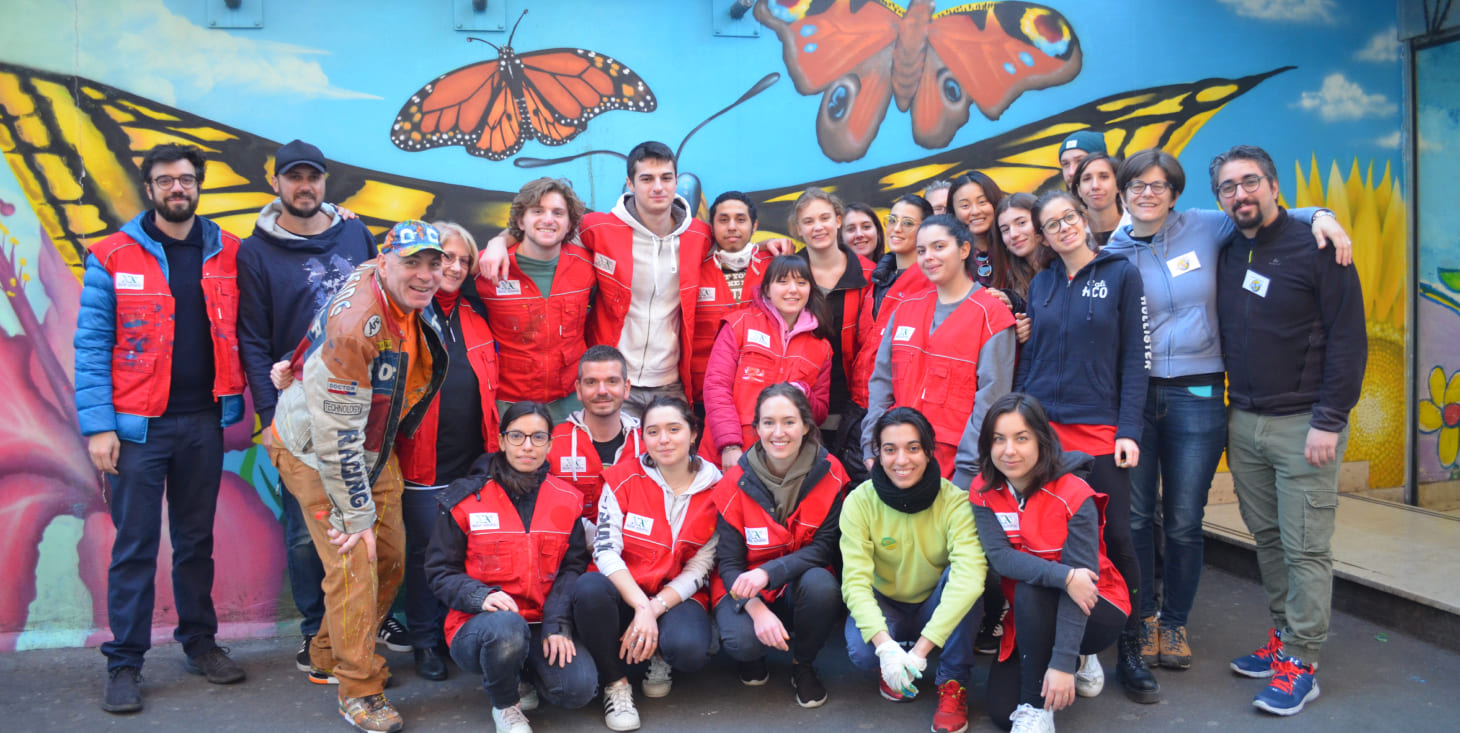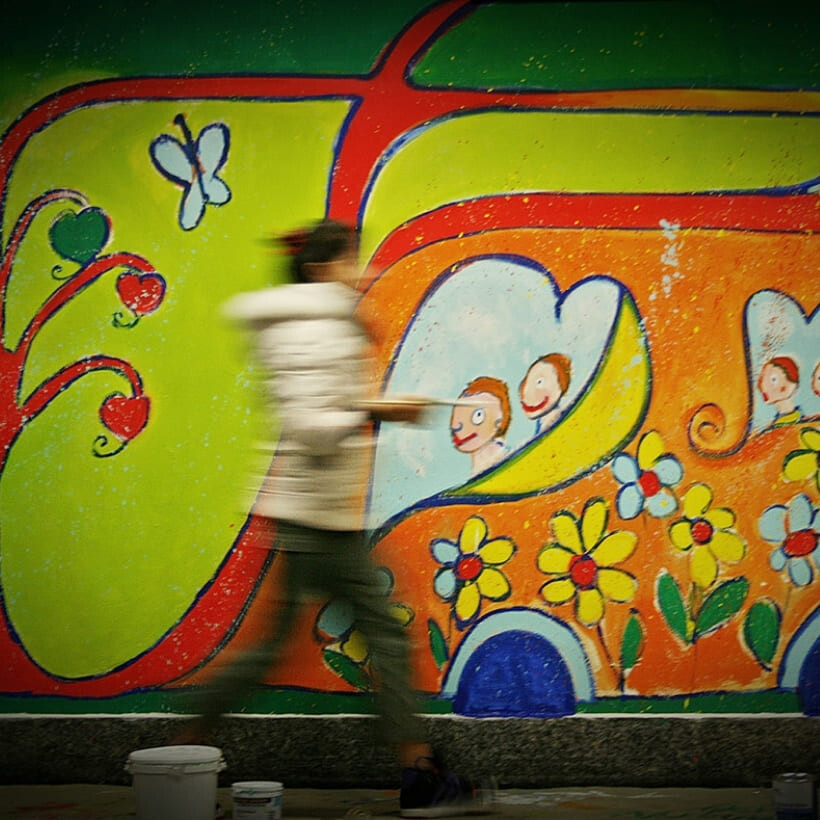There is a magic tunnel at Portanuova: the Garibaldi Station Tunnel
At first sight, you may be confused and say: “Why do you want me to go in a tunnel?”. A tunnel like the ones from noir books or American movies; the underpasses where, at night, under the pouring rain, something unpleasant always happens. But there’s always an exception. There is a beautiful tunnel adorned with colourful graffiti in Milan, which has become a place of strong social interest. It is the connection between the Milan Garibaldi train station and the exit towards Via Pepe, in the Isola area. A link between two neighbourhoods – Portanuova and Isola – and a cool spot of Milanese history.

“Burner!”, say graffiti artists when a piece is beautiful and well done. Just like the coloured tunnel of the Garibaldi Station, which has become a “creative hub” thanks to an innovative project by a non-profit organization called Nuova Acropoli Lombardia. The organization has given – through a partnership with RFI (the Italian national railway infrastructure company) of the FS (the Italian national railway service) group, the patronage of the City of Milan, and the Municipality 9 people’s council – new dignity to a very popular area of the city, with the aim to combine safety and urban decorum.
“It is the mood of the beholder that gives the city its form”, wrote Italo Calvino in his “Invisible Cities”. Indeed, someone walk quickly around the city without even looking up while others, step by step, like to observe the city “from the bottom up” and sometimes are surprised by what they see. Because sometimes what they see is a true work of street art.
We fell in love with this walkway at Garibaldi Station, thus wanted to meet Carlotta Di Cesare, a volunteer at Nuova Acropoli Lombardia ODV, to have a closer look at the organization’s project.
PN > Hello Carlotta. Let us say, “burner”, again, like graffiti artists say when a piece is wonderful. Tell us about the organization, your history, and how you work towards urban and social requalification.
CDC > First of all, we always point out we are – above all – a non-profit organization of volunteers. We are an Italian entity existing in 14 cities, including Milan, since 2009. We aim to play our part in the advancement of society through volunteering actions inspired by the greatest values that human beings can express. Through our “active philosophy”, our projects go from the social sphere – thus helping the youth and the aging – to cultural and artistic activities, to urban regeneration and ecology projects. Our “CosiMIpiace” initiative seeks beauty in every location, and its action began, indeed, with the Garibaldi Station tunnel.

PN > Ok, so “CosiMIpiace” is the name of the innovative project we mentioned in our introduction. Could you tell us what the initial concept was?
CDC > The “CosiMIpiace” initiative was actually born in 2011 as “EscoAdIsola” (going out in Isola). The other members of the team and I often took the Garibaldi Station tunnel to go to the organization's HQ. One day, Paola Bafile – our President – saw the pedestrian tunnel and said, “Let’s write to RFI to present an urban regeneration project revolving around that underpass”, which could turn from a sad and grey place to a pleasant location. That’s exactly what happened: RFI immediately and enthusiastically welcomed our proposal. This marked the birth of “EscoAdIsola”, which is called this way because the tunnel leads to the Isola district. With the start of the partnership, we also launched the first call for artists, but it took 3 to finish the job. The topic of the first call was travelling, the second was “the life of artists”, and the third was the Isola park. We also launched a fourth call for high schools, and the Boccioni institute – the winner – decorated a 52-m (171-ft) wall with a comic strip called Spegni la TV e inizia a pensare (“turn off the TV, turn on your brain”). We also created a space called “Spazio EscoAdIsola” in the requalified area to host music performances by young bands that have animated the tunnel and station for several years.
All of the young artists were volunteers and generously contributed to the requalification initiatives.
Following the success of this first project, we worked with RFI for the urban regeneration of other Milan stations such as Porta Genova, Romolo, San Cristoforo, Greco, Pirelli, and Corsico. Consequently, we had to change the name, and it became “CosìMIpiace”, where “MI” stands for “Milan”. The principle behind the work of our organization is, as Plato said, “The good is the beautiful”.
PN > Is it correct to say that Milan is going international with this initiative? Other cities like New York, Paris, or Berlin already host this form – if not even more evolved forms – of street creativity.
CDC > Of course. Street Art has taken on an important role in Milan. There is a myriad of graffiti in numerous neighbourhoods of the city, and today Street Art is interpreted as a beautiful tool for the requalification of the suburbs. It wasn’t the same when we started out 11 years ago, and we’re happy because we were among the first who promoted this kind of art, especially on such a large scale. We know that Street Art comes from afar and has found its distinctive features, protagonists, and currents in each nation. It is a wonderful art form and for various reasons has helped the evolution of Milan.
PN > Now, tell us a bit about yourself. What brought you to Nuova Acropoli Lombardia. What was your path?
CDC > As you may hear from my accent, I’m not from Milan but I was born in Pescara. Like many others, I became a Nuova Acropoli volunteer at a very young age – 16 years – thanks to an offer by my school. I was attracted by the idea to do something for my city and the greater good. Through various initiatives and activities, I found an authentic volunteering experience that helped me grow a lot on a personal level too. I later moved to Milan to study at university and was lucky enough to continue my path with Nuova Acropoli. Being a volunteer means many things: ideals, willpower, generosity, and lots of inventiveness. I thrived along with all the other team members, and these activities are now a fundamental part of my life.
PN > What is your specific role?
CDC > In particular, I have always followed the younger volunteers and the activities at the Bicocca HQ.
PN > Let me ask you, Carlotta: in your opinion, how do art and culture bring communities together? I believe that the combination of art, culture, and community can produce good results and, as you were saying before through Plato’s words, “The good is the beautiful”. What and how much influence do you think such expressions can have within communities?
CDC > Each of these fields draws upon beauty somehow. To have areas of one’s neighbourhood that are expressions of art, culture, and active citizenship is a luxury. In fact, maintenance of the graffiti is a significant aspect of “CosiMIpiace”. Since they are in highly trafficked areas close to the stations it often occurs that they are marred with writing or marks. This is why we involve the young volunteers in periodic maintenance of the murals, giving them the tangible chance to internalize the concept of beauty and care for common areas. The people who see us down the street are curious and thank us for what we do. Nurturing beauty brings goodness to the district and community.
PN > What will the next step of the project be? Is there a “save-the-date”?
CDC > The most recent decoration was made on the Leonardo Community Street Art Day in 2019: 250 metres (820 ft) of graffiti dedicated to Leonardo da Vinci along the walls of Via Pepe. As you can imagine, COVID stopped us almost completely. Many of the murals were tarnished during the lockdown period, which is why at the beginning of 2023 we will launch a call for artists to create new murals at the Milan Porta Garibaldi station. In the meantime, we are planning a new initiative for promotion and public involvement – hopefully in Piazza Gae Aulenti – to talk to the people and present our future projects, which may come to life even thanks to their help.
PN > One last question: how can we give you a hand?
CDC > Our organization is always open to new partnerships with other organizations or companies. There is an updated “Schedule of activities” section on our website nuovaacropoli.it. You can take part as one-off volunteers for specific initiatives or, for those of you wishing to join our team and train with us, you may choose among the different volunteering areas. Simply contact us by e-mail (milano@nuovaacropoli.it), by calling (0039) 02 3952 7488, or by sending a WhatsApp message to (0039) 392 042 3656.
PN > Thank you, Carlotta! That’s the end of our interview, thanks for telling us about your world.
cosimipiace.it